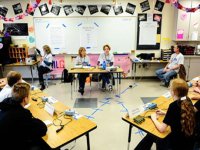3 Strategies to Promote Independent Thinking in Classrooms
Your content has been saved!
Go to My Saved Content.Imagine the intentional focus you would bring to crossing a rushing creek. Each stepping-stone is different in shape, each distance uneven and unpredictable, requiring you to tread with all senses intact. The simple act of traversing water on stones is an extraordinary exercise in concentration. Now think of how, with all the tweeting, texting and messaging that technology has given us, our attention is frittered away by the mundane. The speed of communication undermines the continuum of thought. That rushing creek is much harder to cross.
In his study of people who find satisfaction with their lives, Harvard psychologist Mihaly Csikszentmihalyi defines as autotelic those who are happiest when they are absorbed in complex activities. By focusing on tasks and outcomes that stretch their skills, these young people are more likely to grow into contented adults. The most significant factor for autotelic development is what Csikszentmihalyi terms attentional capacity. Consequently, if his research into self-motivated learning is correct, then the classroom should become an incubator for growing students' attentional capacity. Instruction should be organized in intriguing yet challenging ways to foster attention.
Teachers can utilize three strategies to cultivate improved focus: sequencing instruction, recovery from mistakes, and setting goals.
1. Sequencing Instruction
Finding intriguing ways to sequence information is one method for promoting students' sense of discovery. One science teacher organizes his physical science class into circus labs. This requires that his students, instead of all doing the same activity in the same period, will instead be working on independent investigations to teach one aspect of the lesson. To understand the concept of "heat," they rotate among 14 different explorations over the two-week unit. Each lab forces students to collaborate as they uncover scientific properties. After all the labs are complete, they have a fuller picture of heat's physical properties. Students have reported these activities as intriguing, compelling and shared -- all of which promoted long-term concentration to make the learning more effective.
2. Recovery from Mistakes
Learning from past errors also provides capacity for continued student learning. Here are two unique approaches demonstrating this method.
A math teacher begins each class with a simple question: "Who made the biggest mistake last night?" Then he waits for volunteers to share errors from their homework. After correcting one volunteer's problem, he challenges the other students: "That wasn't a big enough mistake. Surely somebody else made a bigger one than that!" With his generous encouragement for learning from failure, he ratchets up his students' curiosity for process solutions. Revisiting and revising will concentrate the mind if done without judgment.
Another example of recovery from mistake making is through teaching students how to improve their writing by having them revise papers they've already written. Students who experiment with new sentence patterns and advanced grammatical structures, not from a textbook but from their own previous essays, are learning from application. For improved expression, this is far more motivating and worthwhile than going back to a less personal source.
3. Setting Goals
Teachers also have success by incorporating purposeful goals in classroom instruction. If students can be motivated into exploration and discovery in any subject, they will set certain goals for themselves in the classroom. The teacher, by encouraging such goal setting, cultivates their focus even further. For example, in an American studies course, one teacher centers students on the Big Question of the week. The first week begins with a very compelling question. "Who is an American?" she writes in large letters on the board. Through aligning the central intention early in the period and opening doors for understanding, she provides a scaffold for ongoing dialogue. As another example, a biology teacher poses the question: "What is living?" Again, the psychic energy in the class is amplified. This central question alone funnels the course readings, class discussion and research into a purposeful focus.
By testing and analyzing unique ideas, the classroom can grow students' attentional capacity and show them the value of and methods for thinking independently. Only through strategy and design can the classroom become a laboratory of focus and attention. This is what we must do if we want schools to fulfill their purpose: developing young minds that have been assured new ideas are exciting and worth pursuing.
How do you encourage independent thinking in your classroom?
